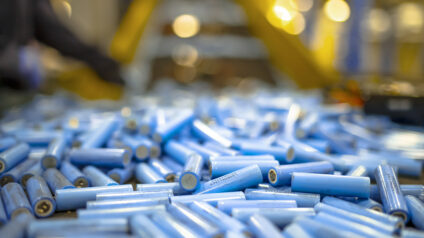



February 10, 2021



February 10, 2021 – Zak Milner
From their use in electric vehicles, to powering your mobile phones, rechargeable lithium-ion batteries have revolutionised 21st century technology. However, the main recycling process of lithium-ion batteries expends copious amounts of energy, whilst only recovering 30 to 40% of the metals.
The process can recover at least 96% of the battery metal
Now, a new, sustainable technology has been developed that allows the recycling of precious metals from used lithium-ion batteries at room temperature, helping to counterract the environmental impacts of this technology. The process has been developed by scientists at the Idaho National Laboratory, who report metal recovery rates of at least 96%.
So, how does the technology work? Through melting their components in a process known as smelting, the individual metals can be separated and regenerated. The new, Idaho- founded technology uses electricity to perform a metal extraction process known as hydrometallurgy. This entails moving the metal components, including lithium, cobalt, nickel and manganese, from broken down lithium-ion batteries into a surrounding solution.
The resulting solution can then be processed to produce pure forms of each metal, whilst the electricity used to power these chemical reactions can be generated sustainably from renewable energy sources, such as solar and wind power. Researchers report that this new technology can be operated at 80% lower cost than current technologies, as the reaction can be carried out at room temperature.
The global lithium-ion battery market is predicted to be worth around $83 billion by 2027, due to the batteries’ use in green energy technologies required to combat climate change. The rapidly increasing demand for their raw materials is now unable to be sustained through mining alone.
Lithium-ion battery recycling is set to be an $18 billion market by 2030
Battery recycling company Li-Cycle predicts that 15 million tonnes of lithium-ion batteries are to be discarded by 2030, a waste growth increase of 2000%, causing catastrophic environmental impacts should they be sent to landfill. This new, cost-competitive recycling technology allows the contribution of raw materials to lithium-ion battery supply chains in an environmentally friendly manner, whilst minimising battery waste sent to landfill. China is currently the global leader in lithium-ion battery recycling, processing around 40% of the 180,000 tonnes of batteries available in 2019, followed by South Korea, who processed 10%.
International businesses investing in research and development, and large-scale recycling facilities include Neometals, Green Li-ion and American Manganese. Recycling targets are to be announced to encourage the use of recycled metals in lithium-ion batteries in Europe, particularly in the electric vehicle market. The European Commission has proposed that all electric vehicle companies must declare the recycled cobalt, lead, nickel and lithium content of their lithium-ion batteries from 2027. Further to this, from 2030, electric vehicle makers will have to meet a minimum recycled content threshold which will steadily increase over time.
Through the recycling of battery metals, European countries aim to produce their own supply of raw materials, have less reliance on imports and, therefore, be able to compete in this emerging market.
